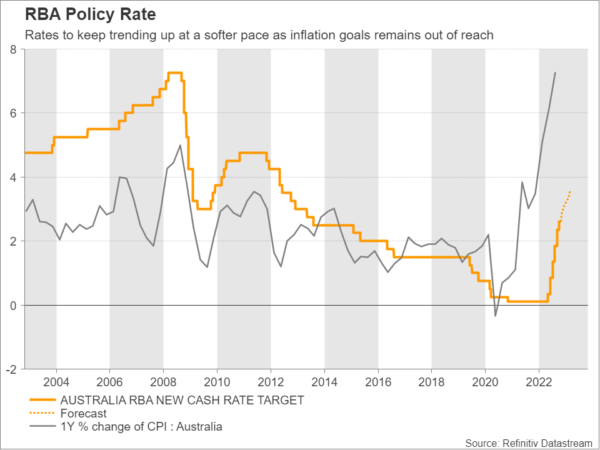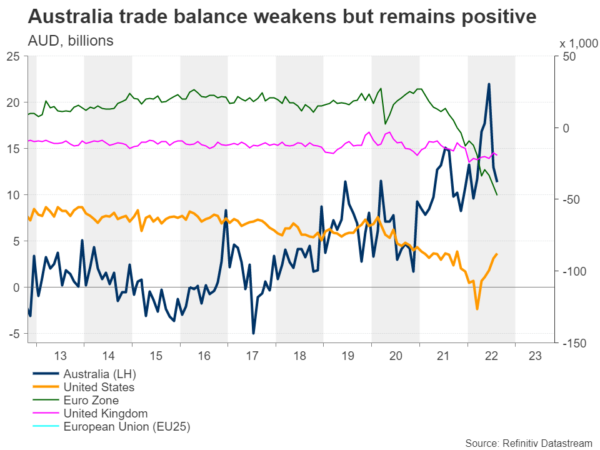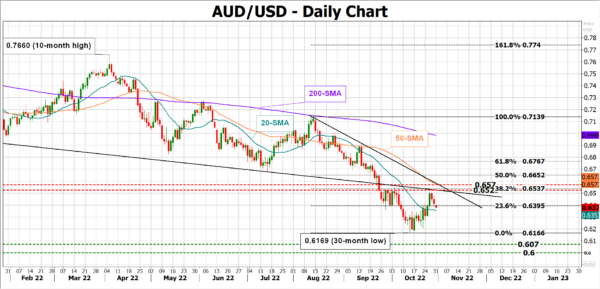The Reserve Bank of Australia (RBA) took the initiative to slow the pace of its rate hikes in October after five months of rapid increases. The latest inflation release, however, raised speculation that a U-turn to outsized rate moves could be possible during Tuesday’s policy meeting. A resumption of the hawkish stance could lift the aussie, albeit temporarily.
Sharp rate hikes back under the spotlight
Fears that a continuous aggressive monetary tightening could backfire with undesirable economic shocks in the foreseeable future made the case for a smaller 25 bps rate hike at the start of October. The RBA was the first among major central banks to surprisingly ease its hawkish rhetoric, though the latest inflation report signaled that the shift was premature.
Despite 225 bps of significant rate increases over the past five months, the headline CPI advanced above expectations to unlock a new 32-year high at 7.3% y/y in the third quarter. Strikingly, the core measures rose at a much faster pace, suggesting that Australia is not different from other major economies which are struggling to contain growth in consumer prices. Consequently, the data sparked conversations for a reversal to 50bps rate hikes, although most analysts keep seeing only a modest 25 bps rate increase for this meeting.
Australia’s outlook is still cloudy
Of course, there are some internal signs that the economy is losing momentum and a careful approach is necessary. Housing finance approvals are expected to slow further in September after a 3.4% decline in August, suggesting that rising borrowing costs are already adding pressure to highly indebted Australian households. Also, the latest business PMI survey revealed deteriorating activity in the services sector, which experienced the largest contraction in demand since September 2021.
External developments are not favorable at present either. Besides the geopolitical turmoil in Ukraine, China’s persisting zero-covid measures could delay the supply of products and services and ease demand for Australian exports. Note that Australia’s budget released on Tuesday involved an additional A$900 million spending for Pacific nations over four years and A$470 million for partners in Southeast Asia to counter China’s influence.
A 50 bps rate hike could be ideal
On the other hand, Australia is still in a relatively better place in terms of trade and budget balances when compared to other nations. The labor market is tight, and consumption, as proxied by retail sales, remains resilient in the growth territory, even though wages are lagging inflation. Hence, while that provides some extra space for monetary tightening, a second gradual 25 bps rate hike in a row this month could create the impression that the RBA is not committed to its inflation task. That is something the central bank could easily avoid by sacrificing some credibility and raising interest rates by 50 bps.
Besides, the minutes from October’s meeting have clearly stated that the “size and timing of future interest rate increases will continue to be determined by the incoming data and the Board’s assessment of the outlook for inflation and the labour market”. Therefore, policymakers could easily justify a sharper rate increase without significantly violating their guidance.
Aussie/dollar
Turning to FX markets, a sharper-than-expected rate hike could help the aussie to gain some extra ground against the US dollar, especially if the rate announcement is coupled with an upward revision in inflation projections. A confirmation that the Fed could reach its terminal interest rate sooner than later and a less exciting nonfarm payrolls report could trigger another bullish episode for the aussie at the end of the week. Still, how durable any upleg could be, and more importantly, whether the broad downtrend in aussie/dollar could soon reverse is questionable.
From a technical perspective, a decisive bounce above the 0.6320-0.6570 resistance is required to activate strong upside pressures up to the 0.6650-0.6680 constraining area. Otherwise, a pullback below 0.6300 may bring the 0.6200- 0.6169 floor back under examination. Failure to pivot here could worsen the downtrend to 0.6070-0.6000.
















